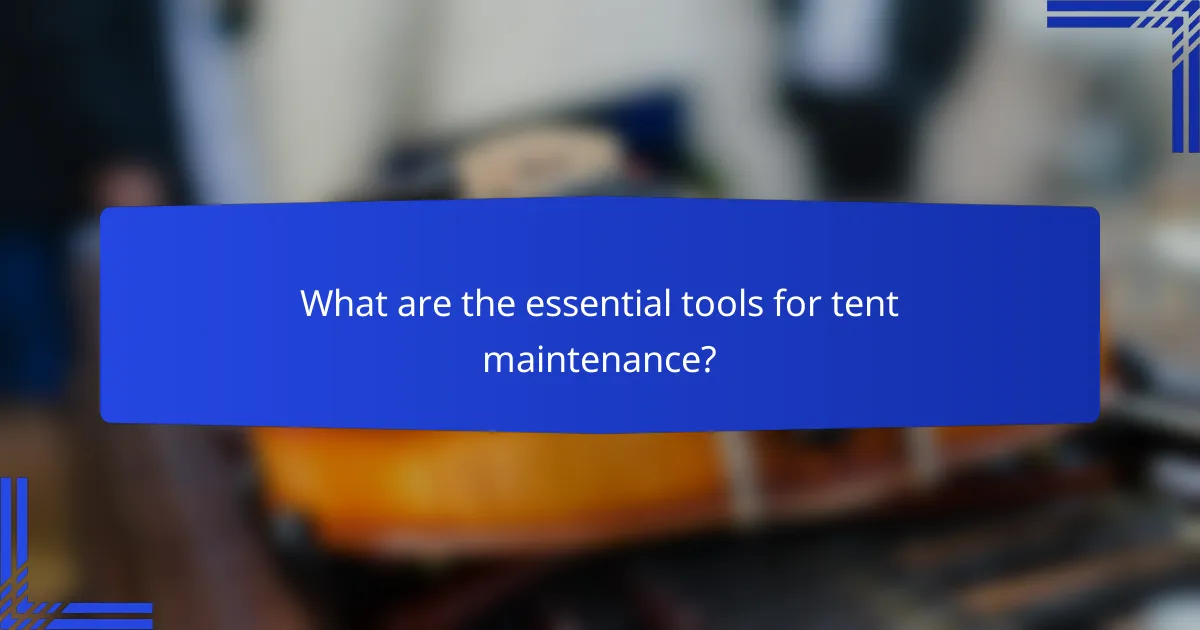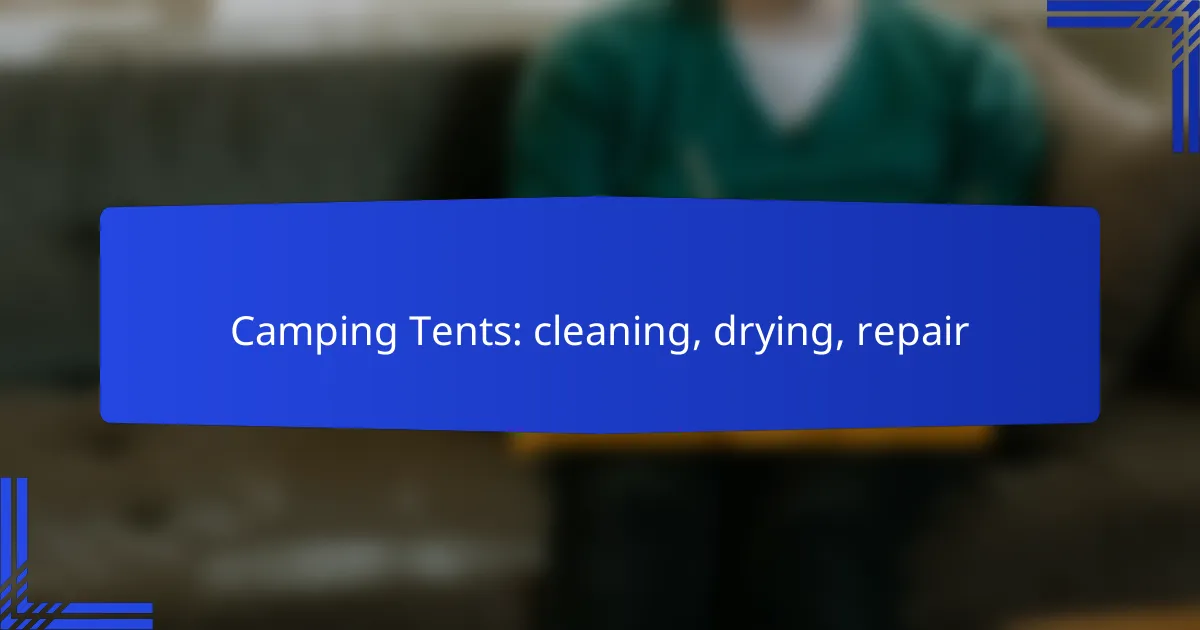Proper care of camping tents is essential for ensuring their longevity and performance. This includes regular cleaning with mild soap and water, thorough drying techniques to prevent mold, and prompt repairs for any damage. By following these practices, campers can enjoy a reliable shelter in various outdoor conditions.

How to clean camping tents in New Zealand?
Cleaning camping tents in New Zealand involves using mild soap and water, removing dirt and debris, and ensuring the tent is completely air-dried. This process helps maintain the tent’s integrity and prolongs its lifespan, especially in the diverse New Zealand climate.
Use mild soap and water
Start by using a mild soap mixed with water to clean your camping tent. Avoid harsh detergents, as they can damage the fabric and waterproof coatings. A gentle dish soap or a specialized tent cleaner is usually sufficient.
Mix the soap with lukewarm water in a bucket. Use a soft sponge or cloth to apply the soapy water to the tent, focusing on stained areas or spots where dirt accumulates. Rinse thoroughly with clean water to remove all soap residue.
Remove dirt and debris
Before washing, shake out the tent to remove loose dirt and debris. You can also use a soft brush or a vacuum cleaner with a brush attachment to get rid of stubborn particles. Pay special attention to corners and seams where dirt tends to collect.
For more persistent stains, consider using a soft-bristled brush with your soapy water mixture. Gently scrub these areas to avoid damaging the fabric while effectively removing dirt.
Air dry completely
After cleaning, it’s crucial to air dry your tent completely before storing it. Set it up in a shaded area to prevent UV damage, and avoid direct sunlight, which can degrade the material over time. Ensure all parts, including zippers and seams, are dry to prevent mold and mildew.
Leave the tent open for several hours, or until it feels completely dry to the touch. If possible, hang it up or lay it flat on a clean surface to facilitate even drying. Storing a damp tent can lead to unpleasant odors and damage, so take this step seriously.

What are the best methods for drying camping tents?
The best methods for drying camping tents include hanging them in a shaded area, using a fan for airflow, and avoiding direct sunlight. These techniques help prevent mold and mildew while ensuring the tent dries thoroughly and maintains its integrity.
Hang in a shaded area
Hanging your camping tent in a shaded area is crucial for effective drying. This method allows moisture to evaporate without the risk of heat damage that can occur in direct sunlight. Aim to use a sturdy tree branch or a clothesline, ensuring the tent is fully extended to promote airflow.
When hanging, make sure the tent is clean and free of debris. If possible, use a tent footprint or tarp underneath to catch any drips, keeping the area tidy and preventing any additional moisture from the ground.
Use a fan for airflow
Using a fan can significantly enhance the drying process by promoting airflow around the tent. Position the fan to blow air directly into the tent, which helps to circulate the air and speed up evaporation. This method is particularly effective in humid conditions where natural airflow may be limited.
For optimal results, consider using a battery-operated fan if you’re in a remote location without power. This can be a game-changer for drying your tent quickly and efficiently, especially after a rainy camping trip.
Avoid direct sunlight
Avoiding direct sunlight is essential when drying camping tents, as UV rays can degrade the fabric over time. Prolonged exposure can lead to fading, weakening, and eventual failure of the tent material. Instead, focus on shaded areas or use a tarp to provide cover while still allowing for airflow.
While it might be tempting to dry your tent quickly in the sun, remember that the long-term health of the fabric is more important. Take your time and use the methods mentioned to ensure your tent remains in good condition for future adventures.

How to repair camping tents effectively?
Repairing camping tents effectively involves using the right tools and techniques to address common issues like tears and broken poles. Quick and proper repairs can extend the life of your tent and ensure a comfortable camping experience.
Use a tent repair kit
A tent repair kit is essential for effective repairs, as it contains all the necessary tools and materials. Look for kits that include adhesive patches, seam tape, and a repair manual. Having a kit on hand allows for quick fixes while camping, minimizing downtime.
When selecting a repair kit, ensure it is compatible with your tent’s fabric type, whether it’s nylon, polyester, or canvas. Some kits may also include specialized items like pole repair sleeves or fabric glue, which can be particularly useful.
Patch holes with fabric adhesive
To patch holes in your tent, clean the area around the tear and apply a fabric adhesive patch. Cut the patch slightly larger than the hole and press it firmly onto the damaged area. Allow it to cure as per the manufacturer’s instructions to ensure a strong bond.
For larger tears, consider using a combination of adhesive and seam tape for added strength. Always carry extra patches in your repair kit, as they can be a lifesaver in the field.
Replace broken poles
If your tent poles are broken, they can often be replaced with new ones or repaired using pole repair sleeves. Measure the length and diameter of the broken pole to find a suitable replacement. Many outdoor retailers offer universal pole repair options that can fit various tent brands.
When replacing poles, check for compatibility with your tent model to ensure proper fit and function. If you’re in a remote area, using duct tape or a similar strong tape can temporarily hold the pole together until you can replace it properly.

What are the essential tools for tent maintenance?
Essential tools for tent maintenance include a multi-tool for repairs, a cleaning brush for dirt removal, and seam sealer for waterproofing. These tools help ensure your tent remains in good condition, extending its lifespan and performance during camping trips.
Multi-tool for repairs
A multi-tool is invaluable for making quick repairs on the go. Look for one that includes a knife, pliers, and screwdrivers, as these can address common issues like broken poles or loose fittings. When selecting a multi-tool, consider its weight and size to ensure it’s portable enough for camping.
Regularly check your multi-tool for functionality and keep it clean. A well-maintained tool can save you from a frustrating situation when you need to fix your tent in the field.
Cleaning brush for dirt removal
A cleaning brush is essential for removing dirt and debris from your tent fabric. Choose a brush with soft bristles to avoid damaging the material while effectively cleaning off mud and dust. Regular cleaning helps maintain the tent’s integrity and prevents mold growth.
After each camping trip, brush off any loose dirt before packing your tent away. This simple step can significantly reduce the need for deep cleaning later and prolong the life of your tent.
Seam sealer for waterproofing
Seam sealer is crucial for maintaining the waterproof integrity of your tent. Over time, seams can wear down, allowing water to seep in. Applying seam sealer regularly, especially after cleaning, can help prevent leaks during rainy conditions.
When using seam sealer, ensure the tent is clean and dry. Follow the manufacturer’s instructions for application, and consider reapplying every season or after extensive use to keep your tent in optimal condition.

What are the common mistakes in tent care?
Common mistakes in tent care include improper storage, neglecting small damages, and using harsh cleaning chemicals. These oversights can significantly reduce the lifespan and performance of your tent.
Storing wet tents
Storing a wet tent can lead to mold and mildew growth, which damages the fabric and affects its waterproofing. Always ensure your tent is completely dry before packing it away for an extended period.
If you must store a wet tent temporarily, try to air it out in a well-ventilated area to minimize moisture retention. Aim to dry it within a few hours to prevent long-term damage.
Ignoring small damages
Small damages, such as minor tears or broken zippers, can escalate if left unaddressed. Regularly inspect your tent for any signs of wear and tear, especially after each camping trip.
Repairing small issues promptly can save you from costly repairs or the need to replace the tent entirely. Use a tent repair kit to patch holes or replace damaged components as soon as you notice them.
Using harsh chemicals
Harsh chemicals can degrade the tent fabric and waterproof coatings, leading to reduced performance. Stick to mild soap and water for cleaning your tent, avoiding bleach or other strong cleaners.
When cleaning, use a soft sponge or cloth to gently scrub the surface. Rinse thoroughly to ensure no soap residue remains, which can attract dirt and grime over time.
